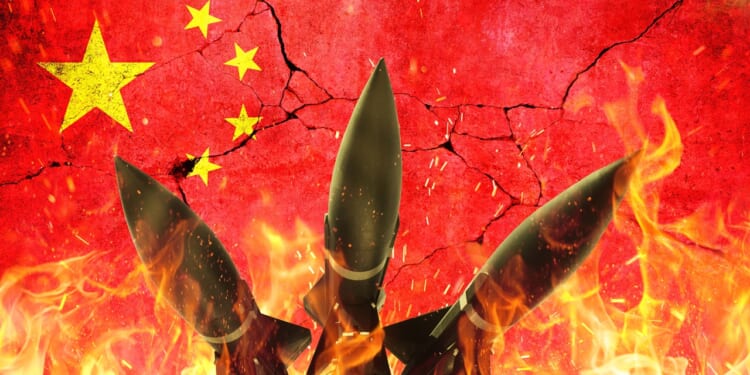For strategic reasons, China has intentionally remained opaque about its nuclear arsenal and delivery mechanisms—in stark contrast to the relative openness of the American and Russian programs.
China’s revisionist stance has spiked concern over its growing military capabilities, with special attention being paid to the regime’s ability to deploy nuclear weapons. Public information on the scope of China’s warhead stockpile is opaque—intentionally so, as Beijing remains tight-lipped about its nuclear capacity, unlike most nuclear nations—but estimates hold that the regime has stockpiled several hundred warheads, and that the deployment methods are being diversified and modernized.
China Has a Nuclear Triad
China is one of the few nations with a functioning nuclear triad.
- On land, the People’s Liberation Army Rocket Force (PLARF) fields a variety of intercontinental ballistic missiles (ICBMs): road-mobile solid ICBMs such as the DF-31 family, large solid ICBMs like the DF-41, and older silo and liquid ICBMs like the liquid-fueled DF-5. The PLARF also possesses shorter-range ballistic missiles, like the DF-16 and DF-21 (including the DF-21D “carrier killer”), for regional exchanges.
- At sea, the People’s Liberation Army Navy (PLAN) provides China with a credible second-strike option. The JL-2 and JL-3 submarine-launched ballistic missile (SLBM), outfitted aboard the Type 094 Jin class submarine, allows China to patrol more distant waters, threatening continental targets, like the US mainland, with a nuclear strike.
- From the air, the People’s Liberation Army Air Force (PLAAF) can deploy the CJ-20 air-launched cruise missile from the H-6 strategic bomber. While the H-6 is terribly outdated, efforts are underway to field both a modern strategic bomber (the H-20) and tactical bomber (JH-XX) capable of deploying nuclear weapons.
China’s ongoing and comprehensive military modernization efforts have included updates to nuclear delivery technology. China is moving toward, or has already fielded, MIRV-upgraded ICBMs that include multiple warheads per missile—thereby increasing warhead counts and complicating missile-defense calculations.
Simultaneously, China is pivoting towards greater use of solid propellant missiles, which increases responsiveness and survivability relative to liquid propellent ones. And improved guidance and accuracy, courtesy of modern guidance suites, has resulted in more nuanced targeting abilities, again complicating defensive efforts.
China is also modernizing the warheads themselves, specifically with efforts to miniaturize, and potentially, to offer variable yields (allowing for tactical to strategic deployment).
China Might Have Recently Changed Its Nuclear Doctrine
Historically—and still officially—China has a No First Use (NFU) doctrine, maintaining that its nuclear arsenal is strictly for deterrence rather than war-fighting. That doctrine was compatible with China’s historic force structure, which was small, slow to launch, and not capable of much more than retaliation. But analysts have grown skeptical of the NFU limitations as China diversifies, disperses, hardens, and increases their nuclear stockpile. The technological adaptations signal greater operational flexibility. The larger, more flexible arsenal increases Beijing’s ability to signal, coerce, or respond—potentially lowering its thresholds for nuclear signaling in a crisis.
The strategic implications of the technological improvements, and the possible correlation in a doctrinal shift, makes China’s regional deterrence stronger—against both regional adversaries and the United States. Allies in the region have taken notice. Japan, South Korea, and Australia rely upon the US “nuclear umbrella.” But as China’s capabilities improve, regional partners may start to question the US commitment to engage in a nuclear confrontation with China over allied territory. And if those doubts are persistent enough, regional partners may pursue their own nuclear programs as a way to strengthen deterrence.
Most consequentially, China’s nuclear improvements signal the rise of a tripolar nuclear world, within which stability depends upon the behavior of the US, Russia, and China. The tripolar arrangement is inherently far less stable than the bygone bipolar nuclear scheme between the United States and the Soviet Union (and later Russia). China’s nuclear rise introduces another variable into world deterrence calculus, with unpredictable and potentially catastrophic consequences.
About the Author: Harrison Kass
Harrison Kass is a senior defense and national security writer at The National Interest. Kass is an attorney and former political candidate who joined the US Air Force as a pilot trainee before being medically discharged. He focuses on military strategy, aerospace, and global security affairs. He holds a JD from the University of Oregon and a master’s in Global Journalism and International Relations from NYU.
Image: Shutterstock / Alones.


















